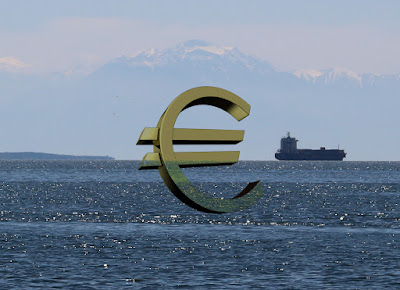Negative rates, financial stability and old-style bank robbers
One of the main means for a central bank to promote financial stability is to set the interest rate at which it lends to banks. The lower the rate, the bigger the incentive for banks to do loans to finance companies and consumers' projects. The relationship is straightforward as long as the interest rate stays positive. Indeed, if the interest rate turns negative, negative side effects start to come up, and the point of this article is to highlight those side effects.
 |
| A Euro dipping in the Aegean sea, in front of Mount Olympus (picture from the author) |
1. Which rates does a central bank set?
A typical central bank actually sets 3 different rates:- Deposit facility rate (or fed funds rate in the USA) = defines the interest banks receive for depositing money with the central bank overnight. It is compulsory for banks to depose part of their capital at the central bank and this amount is called reserve.
- Main refinancing rate (or discount rate in the USA) = defines the interest rate at which banks can borrow from the central bank for a period of one week.
- If banks need money overnight, they can borrow from the marginal lending facility at a higher rate.
The main rate that is being publicized in news conferences and the financial media is the main refinancing rate. Hence, the interest rate will mean from now on the main refinancing rate, except when specified otherwise.
2. How low are rates at the moment?
Inflation is low in a lot of countries in the world at the moment, and as a result a lot of countries' central banks have set their refinancing rates at low levels. Today, there are 18 countries with sub 1% interest rate, and among those 4 countries have set a negative rate. The chart below shows the country names and rates.
Even for the countries that didn't find the need to move to sub-zero rates, it is interesting for them to study the impact of negative rates, because should a negative economic shock happen, countries with already low interest rates might be forced into a negative rate policy to respond to the shock.
3. Negative consequences
3.1. Legal argument
To start with, it is not always clear that all central banks have the authority to set negative interest rates. To set a negative deposit rate, the central bank would have to charge banks on their compulsory deposits. Janet Yellen, the Federal Reserve Chairman, said in February 2016 that “there remain some legal issues to resolve before the Fed could implement a negative interest rate.” [1]
3.2. Money markets disruptions
Money market funds are funds that invest in short term and high quality securities in order to provide a low risk and short-term income to their investors. Faced with negative interest rates, they will probably disappear because an investor can always get a better return by just holding on to its cash. This would be disruptive for the financial system because money market funds are an important source of funding both for banks and non-financial firms.
3.3. Banks under stress
Bank executives are lobbying hard against negative rates because it would also be disruptive to their business model. Deutsche Bank CEO hits out at negative rates[2]. Interest rates on cash and term deposit accounts are linked to the main refinancing rate. To follow the refinancing rate into negative territory, banks would have to charge their customers more for their deposits, but they would hesitate to do so because it would anger their customers who, in turn, could decide to repatriate their money and hold on to their cash. Faced with the risk of cash hoarding, banks would probably choose to squeeze their profits, but there is only so much they can do before the whole banking system is under stress. And indeed, Bank of Japan Governor Haruhiko Kuroda acknowledged on September 5th that "subzero policy rates have had an adverse impact on the profitability of Japanese financial institutions”[3]. Once again, this goes against the objective of financial system stability.
3.4. Vaults
The most efficient way of hoarding cash would probably be to replace money markets funds (composed of people and computers) by vaults company where people would transfer their electronic money to the vaults company and receive a share of the physical currency hold in the vaults instead. This would cause some security issues because old-style bank robbery would become a profitable business again. Furthermore, building vaults is not a productive investment per se.
4. Conclusion
We have highlighted some non-linearity in the impact of negative interest rate policy. Of course, all these disruptions don't appear as soon as the rate becomes slightly negative, so policy makers could have enough room for a modestly negative interest rate. But what it means is that this tool is not a very powerful one because its impact is reduced the further negative interest rate goes on. I am not aware of any model of the impact of this negative interest rate non linearity but it would be an interesting area of study.
I will finish with a quote from one of my favorite central bank governors, Mark Carney from the Bank of England (btw his reaction after Brexit was admirable: calm, determined and in control), who has ruled out using negative interest rates: “I’m not a fan of negative interest rates. We see the negative consequences of them through the financial system; we’ve seen that in other jurisdictions; we see the issues with savers.” [4]


Sweden's Central Bank chief defending negative rates policy:
ReplyDeletehttps://www.ft.com/content/b5c03c3e-936b-11e6-a1dc-bdf38d484582